Characterization of Seismic Dynamic Response of Uranium Tailings Dams Based on Discrete Element Method
Abstract
:1. Introduction
2. Overview of Uranium Tailings Dams
3. Modeling of Dam Dynamics
3.1. Loading Seismic Loads
3.2. Setting of Boundary Conditions and Damping
4. Analysis of Numerical Simulation Results
5. Analysis of Response-Influencing Factors
5.1. Effect of Seismic Wave Amplitude on Dam Stability
5.2. Effect of Tailings Sand Friction Angle on Dam Stability
5.3. Effect of Seismic Loading Frequency on Dam Stability
6. Conclusions
Author Contributions
Funding
Institutional Review Board Statement
Informed Consent Statement
Data Availability Statement
Acknowledgments
Conflicts of Interest
References
- Rana, N.M.; Ghahramani, N.; Evans, S.G.; McDougall, S.; Small, A.; Take, W.A. Catastrophic mass flows resulting from tailings impoundment failures. Eng. Geol. 2021, 292, 106262. [Google Scholar] [CrossRef]
- Agurto-Detzel, H.; Bianchi, M.; Assumpção, M.; Schimmel, M.; Collaço, B.; Ciardelli, C.; Barbosa, J.R.; Calhau, J. The tailings dam failure of 5 November 2015 in SE Brazil and its preceding seismic sequence. Geophys. Res. Lett. 2016, 43, 4929–4936. [Google Scholar] [CrossRef]
- Dai, X.; Wu, X.; Hong, Y.; Xie, J.; Lin, D.; Chen, Y.; Liu, Y. Safety and stability evaluation of the uranium tailings impoundment dam: Based on the improved AHP-cloud model. J. Radiat. Res. Appl. Sci. 2022, 15, 21–31. [Google Scholar] [CrossRef]
- Owen, J.R.; Kemp, D.; Lèbre, É.; Svobodova, K.; Pérez Murillo, G. Catastrophic tailings dam failures and disaster risk disclosure. Int. J. Disaster Risk Reduct. 2020, 42. [Google Scholar] [CrossRef]
- Jiang, F.; Wu, H.; Liu, Y.; Chen, G.; Guo, J.; Wang, Z. Comprehensive evaluation system for stability of multiple dams in a uranium tailings reservoir: Based on the TOPSIS model and bow tie model. R. Soc. Open Sci. 2020, 7, 191566. [Google Scholar] [CrossRef]
- Islam, K.; Murakami, S. Global-scale impact analysis of mine tailings dam failures: 1915–2020. Glob. Environ. Change 2021, 70. [Google Scholar] [CrossRef]
- Lamour, R.J.A.; Wasserman, M.A.V.; Rochedo, E.R.R.; Lugon Junior, J. Assessment of the environmental radiological impact in the emergency exposure phase through the simulation of a uranium mining tailings dam breach. Braz. J. Radiat. Sci. 2023, 11, 1–20. [Google Scholar] [CrossRef]
- Villavicencio, G.; Espinace, R.; Palma, J.; Fourie, A.; Valenzuela, P. Failures of sand tailings dams in a highly seismic country. Can. Geotech. J. 2013, 51, 449–464. [Google Scholar] [CrossRef]
- Lyu, Z.; Chai, J.; Xu, Z.; Qin, Y.; Cao, J. A Comprehensive Review on Reasons for Tailings Dam Failures Based on Case History. Adv. Civ. Eng. 2019, 2019, 4159306. [Google Scholar] [CrossRef]
- Jin, J.; Ding, Q.; Cui, H.; Zhang, P.; Xiao, X.; Lv, X. Dynamic response characteristics of a tailing dam determined by shaking-table tests. Arab. J. Geosci. 2020, 13, 897. [Google Scholar] [CrossRef]
- Zhou, Z.; Ren, C.; Xu, G.; Zhan, H.; Liu, T. Dynamic Failure Mode and Dynamic Response of High Slope Using Shaking Table Test. Shock. Vibration. 2019, 2019, 4802740. [Google Scholar] [CrossRef]
- Li, Q.; Ma, G.; Li, P.; Su, Z. Dynamic characteristics of tailings dam with geotextile tubes under seismic load. Rev. Adv. Mater. Sci. 2021, 60, 599–614. [Google Scholar] [CrossRef]
- Lin, Q.; Zhang, S.; Liu, H.; Shao, Z. Water saturation effects on the fracturing mechanism of sandstone excavating by TBM disc cutters. Arch. Civ. Mech. Eng. 2024, 24, 154. [Google Scholar] [CrossRef]
- Cao, R.-h.; Yao, R.; Meng, J.; Qibin, L.; Lin, H.; Su, L. Failure mechanism of non-persistent jointed rock-like specimens under uniaxial loading: Laboratory testing. Int. J. Rock Mech. Min. Sci. 2020, 132, 104341. [Google Scholar] [CrossRef]
- Zhu, D.; Yu, B.; Wang, D.; Zhang, Y. Fusion of finite element and machine learning methods to predict rock shear strength parameters. J. Geophys. Eng. 2024, 21, 1183–1193. [Google Scholar] [CrossRef]
- Itasca Consulting Group. 3DEC User Manual; Itasca Consulting Group: Minneapolis, MN, USA, 2019; Available online: https://docs.itascacg.com/3dec700/3dec/docproject/source/3dechome.html (accessed on 7 August 2024).
- Ren, Z.; Wang, K.; Zhang, Q.S.; Xu, Z.M.; Tang, Z.G.; Chen, J.P.; Yang, J.Q.; Xu, Z.H. Earthquake dynamic response behavior of Xiangchong valley type tailings impoundment in Yunnan, China. J. Mt. Sci. 2018, 15, 82–99. [Google Scholar] [CrossRef]
- Chundi, S.; Baolin, X.; Wei, W. Analysis on seismic dynamic response and liquefaction area of tailings dam. Int. J. Comput. Appl. Technol. 2018, 57, 183–191. [Google Scholar] [CrossRef]
- Xu, M.; Yu, X.; Pan, Y.; Liu, X.; Zhao, Y.; Hu, J. Analysis of the seismic dynamic response and failure mode of the Layue landslide. Landslides 2023, 20, 1135–1148. [Google Scholar] [CrossRef]
- Jin, J.; Song, C.; Liang, B.; Chen, Y.; Su, M. Dynamic characteristics of tailings reservoir under seismic load. Environ. Earth Sci. 2018, 77, 654. [Google Scholar] [CrossRef]
- Vijayasri, T. Dynamic characterization of tailing dam using fully coupled dynamic analysis with different boundary conditions—A case study. Earthq. Eng. Eng. Vib. 2023, 22, 995–1013. [Google Scholar] [CrossRef]
- Ferdosi, B.; James, M.; Aubertin, M. Investigation of the Effect of Waste Rock Inclusions Configuration on the Seismic Performance of a Tailings Impoundment. Geotech. Geol. Eng. 2015, 33, 1519–1537. [Google Scholar] [CrossRef]
- Xu, B.; Zhou, Y.; Zhou, C.G.; Kong, X.J.; Zou, D.G. Dynamic responses of concrete-faced rockfill dam due to different seismic motion input methods. Int. J. Distrib. Sens. Netw. 2018, 14, 1550147718804687. [Google Scholar] [CrossRef]
- Yao, Y.; Wang, R.; Liu, T.Y.; Zhang, J.M. Seismic response of high concrete face rockfill dams subjected to non-uniform input motion. Acta Geotech. 2019, 14, 83–100. [Google Scholar] [CrossRef]
- Psarropoulos, P.N.; Tsompanakis, Y. Stability of tailings dams under static and seismic loading. Can. Geotech. J. 2008, 45, 663–675. [Google Scholar] [CrossRef]
- Bićanić, N. Discrete Element Methods. Encycl. Comput. Mech. 2004. [Google Scholar]
- Wu, J.; Wang, Y.; Dong, S.; Chen, Y.; Wang, L. Genetic mechanism and failure process of the Mogangling seismic landslide. J. Geol. Soc. India 2013, 82, 277–282. [Google Scholar] [CrossRef]
- Wang, Y.; Wu, L.Z.; Gu, J. Process analysis of the Moxi earthquake-induced Lantianwan landslide in the Dadu River, China. Bull. Eng. Geol. Environ. 2019, 78, 4731–4742. [Google Scholar] [CrossRef]
- Lemos, J.V.; Dawson, E.M.; Cheng, Z. Application of Maxwell damping in the dynamic analysis of masonry structures with discrete elements. Int. J. Mason. Res. Innov. 2022, 7, 663–686. [Google Scholar] [CrossRef]
- Maxwell Damping: An Alternative to Rayleigh Damping. In Geo-Extreme 2021; American Society of Civil Engineers: Reston, VA, USA, 2021; pp. 34–45. [CrossRef]
- Liu, B.; He, K.; Han, M.; Hu, X.; Wu, T.; Wu, M.; Ma, G. Dynamic process simulation of the Xiaogangjian rockslide occurred in shattered mountain based on 3DEC and DFN. Comput. Geotech. 2021, 134, 104122. [Google Scholar] [CrossRef]
- Fan, X.; Xu, Q.; Scaringi, G.; Dai, L.; Li, W.; Dong, X.; Zhu, X.; Pei, X.; Dai, K.; Havenith, H.-B. Failure mechanism and kinematics of the deadly June 24th 2017 Xinmo landslide, Maoxian, Sichuan, China. Landslides 2017, 14, 2129–2146. [Google Scholar] [CrossRef]
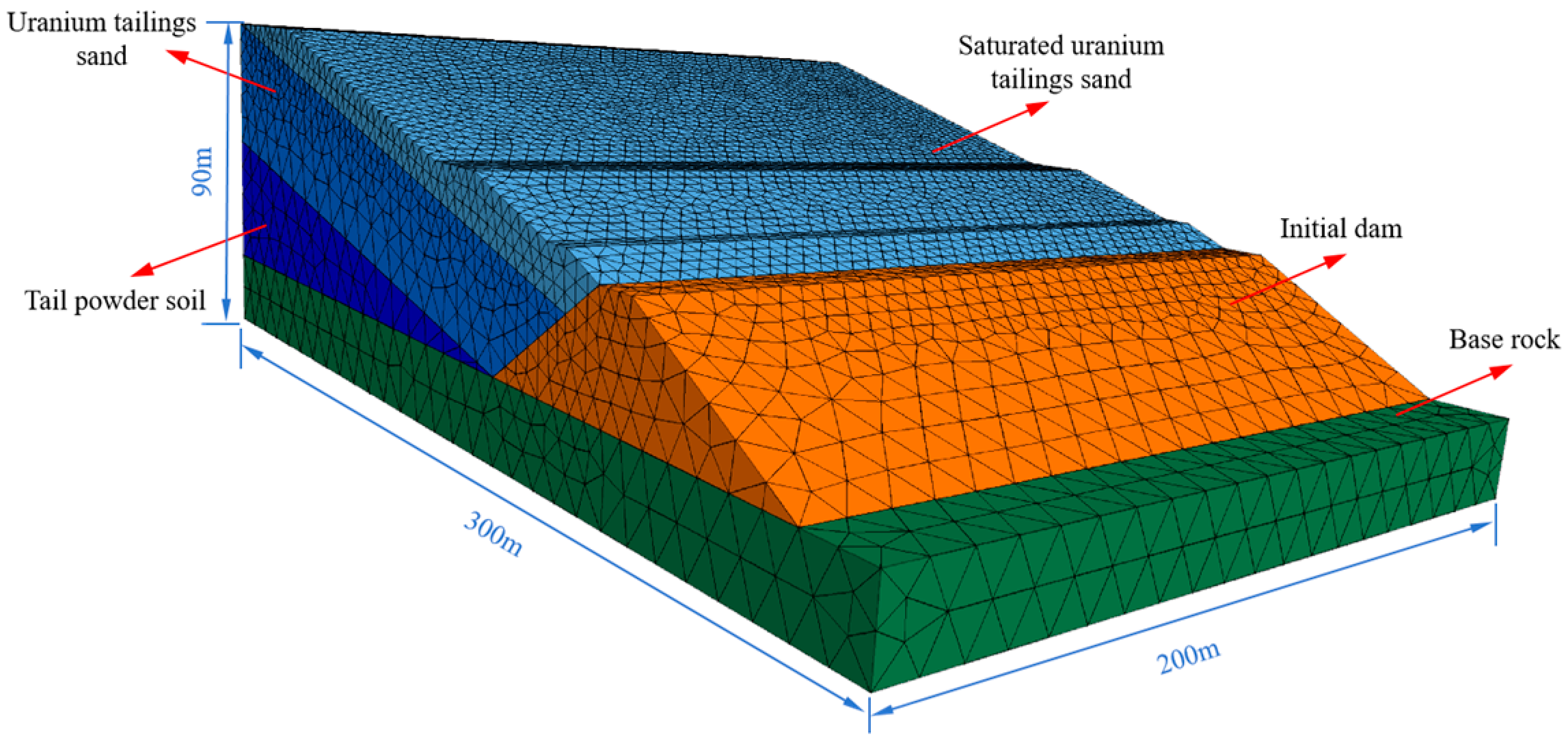
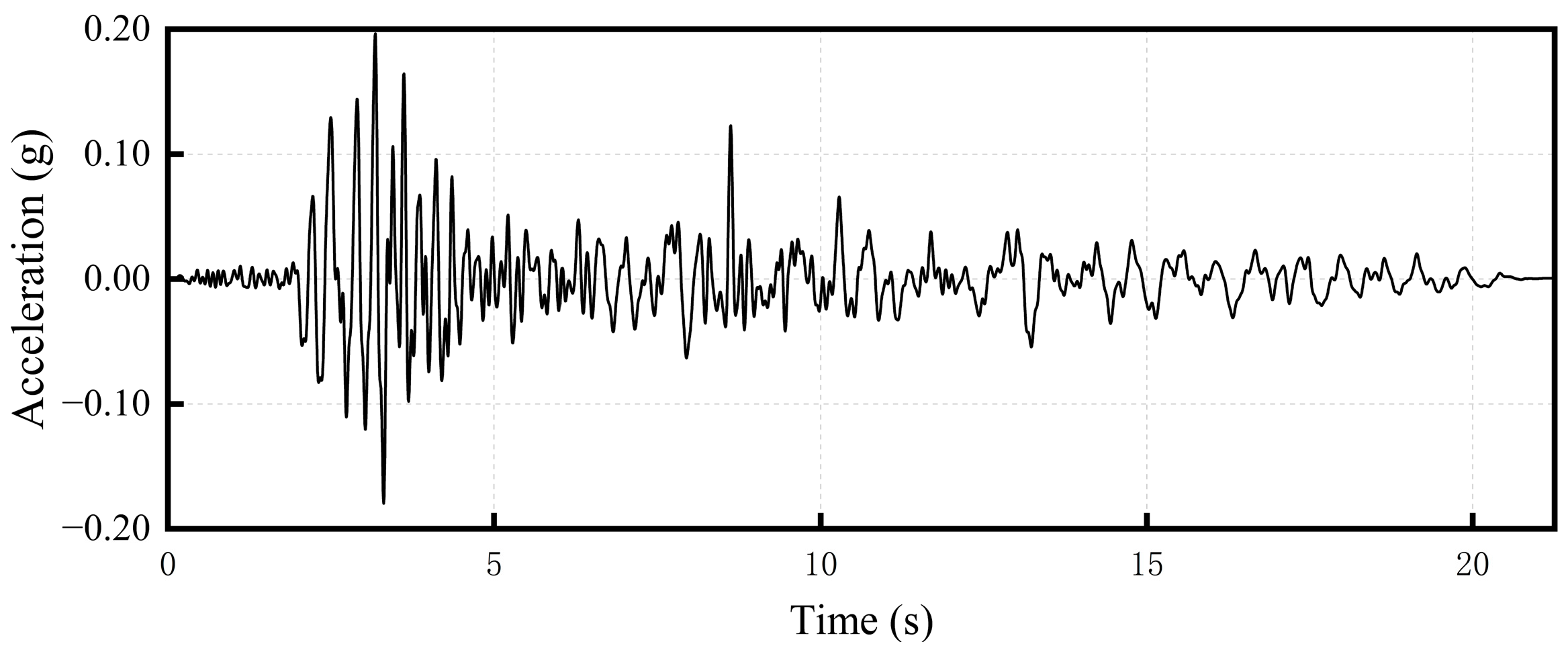

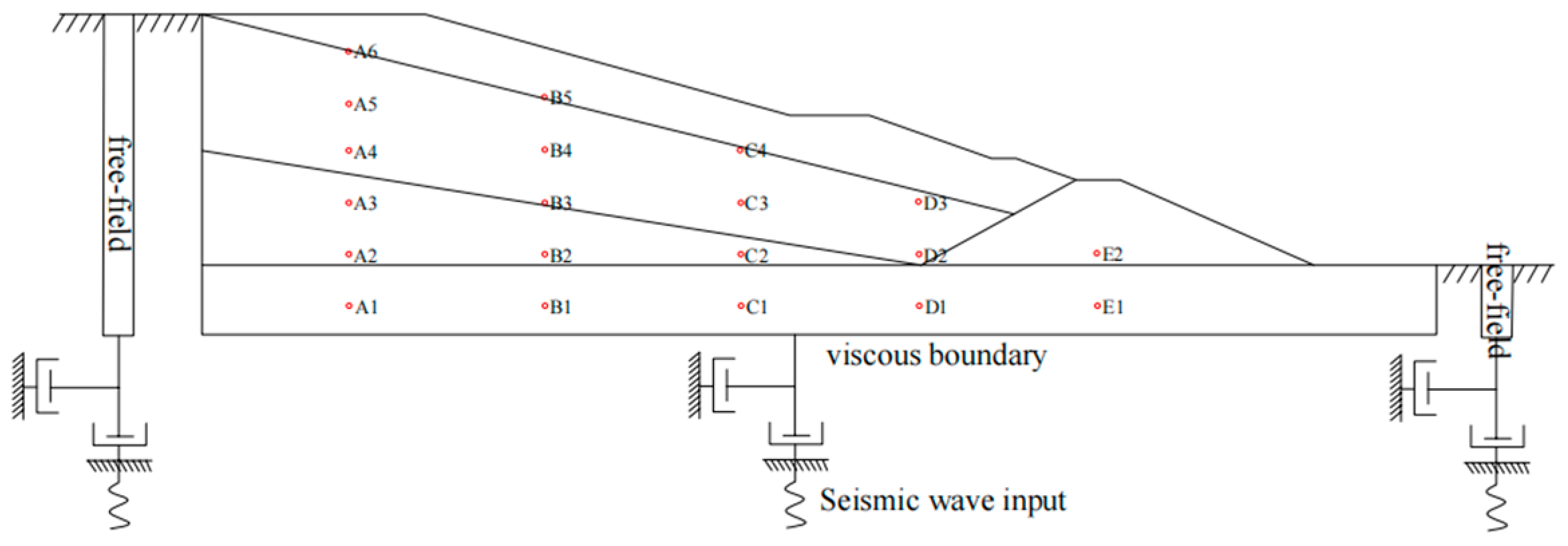




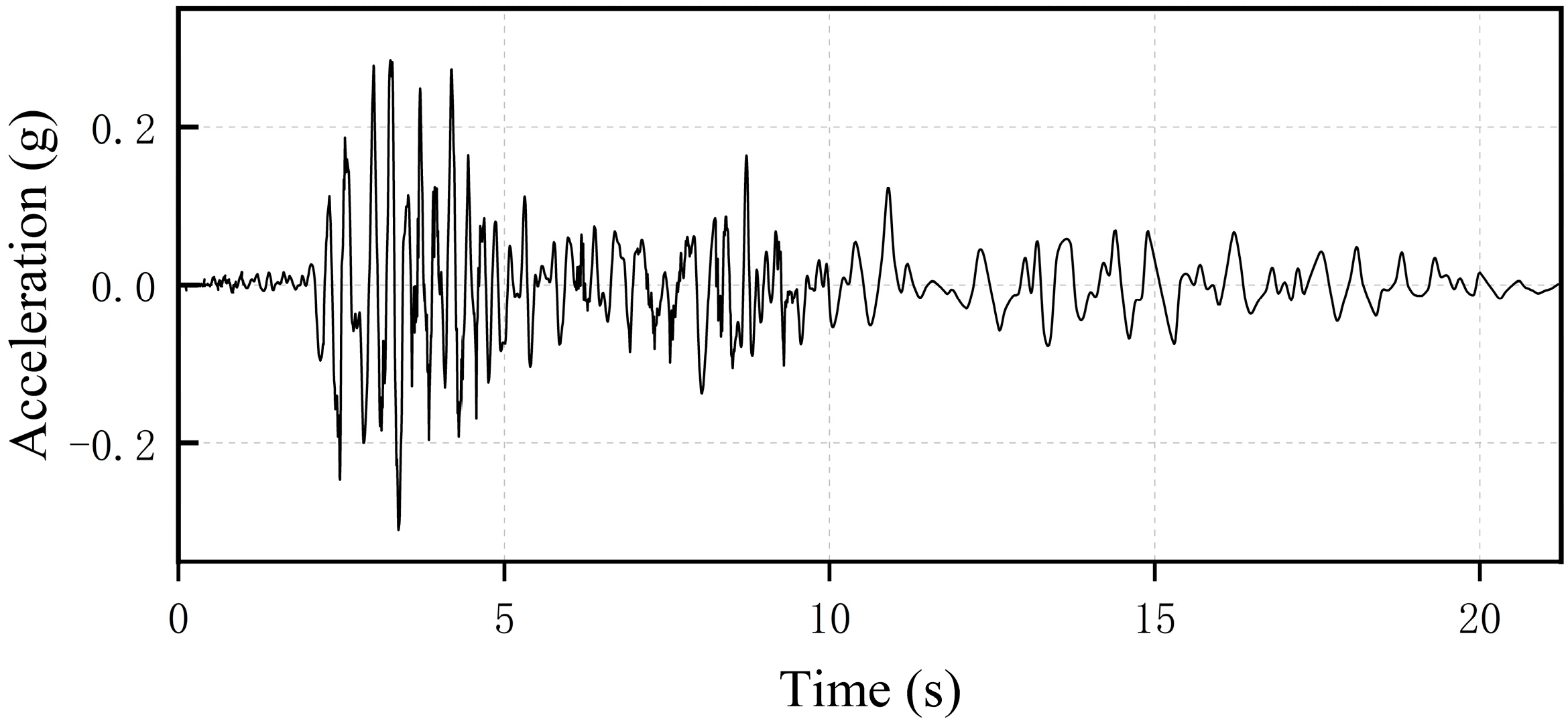

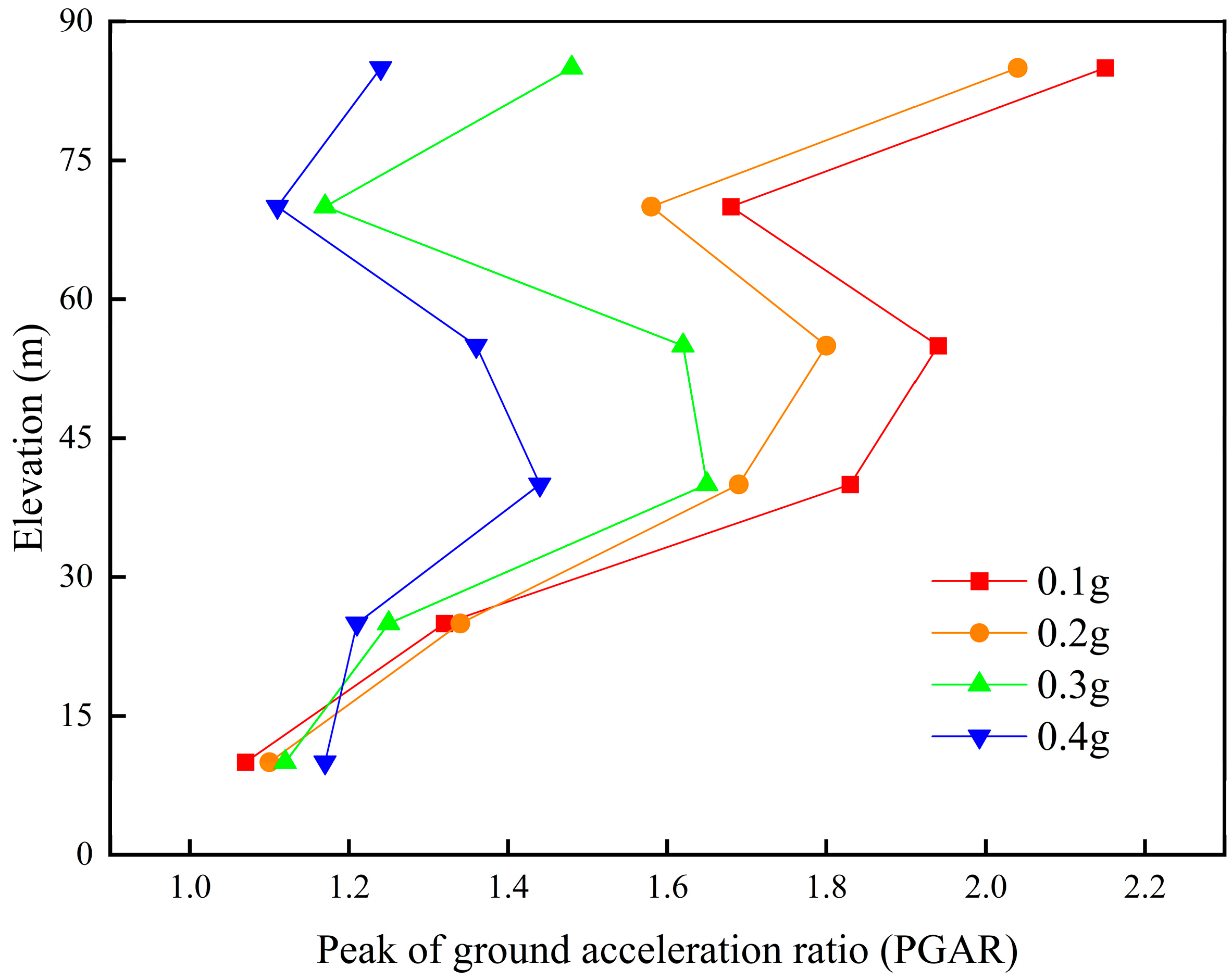

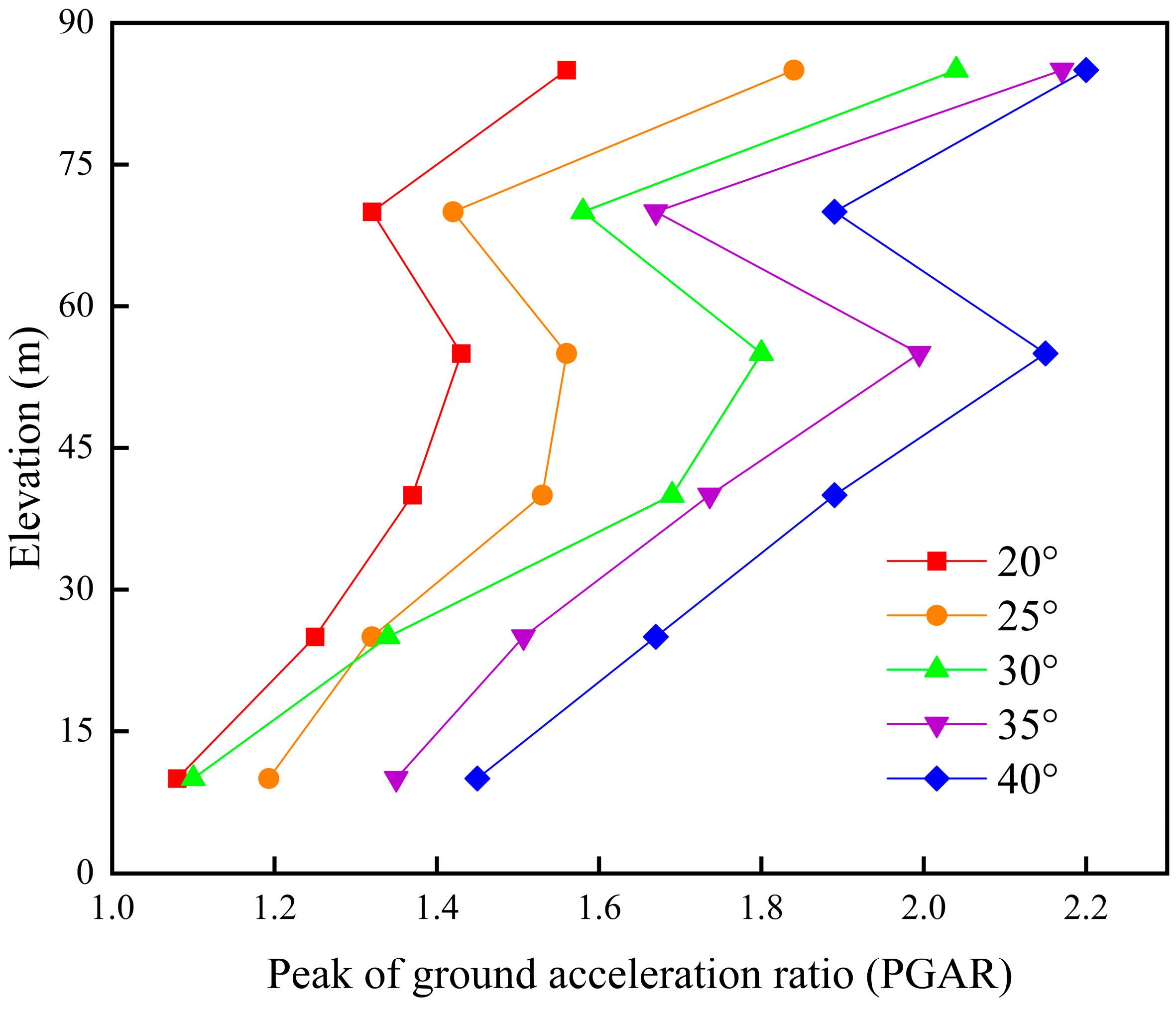
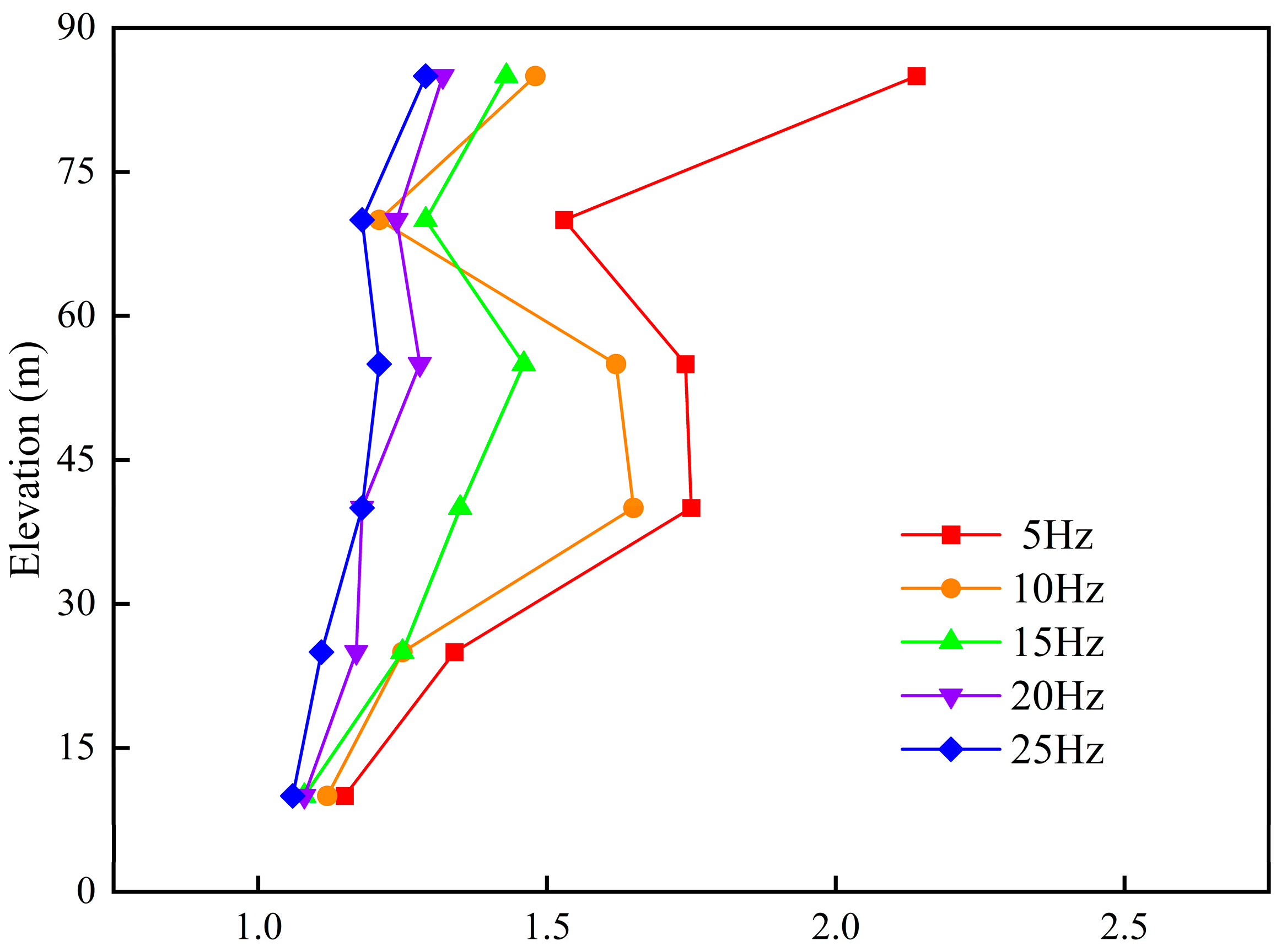
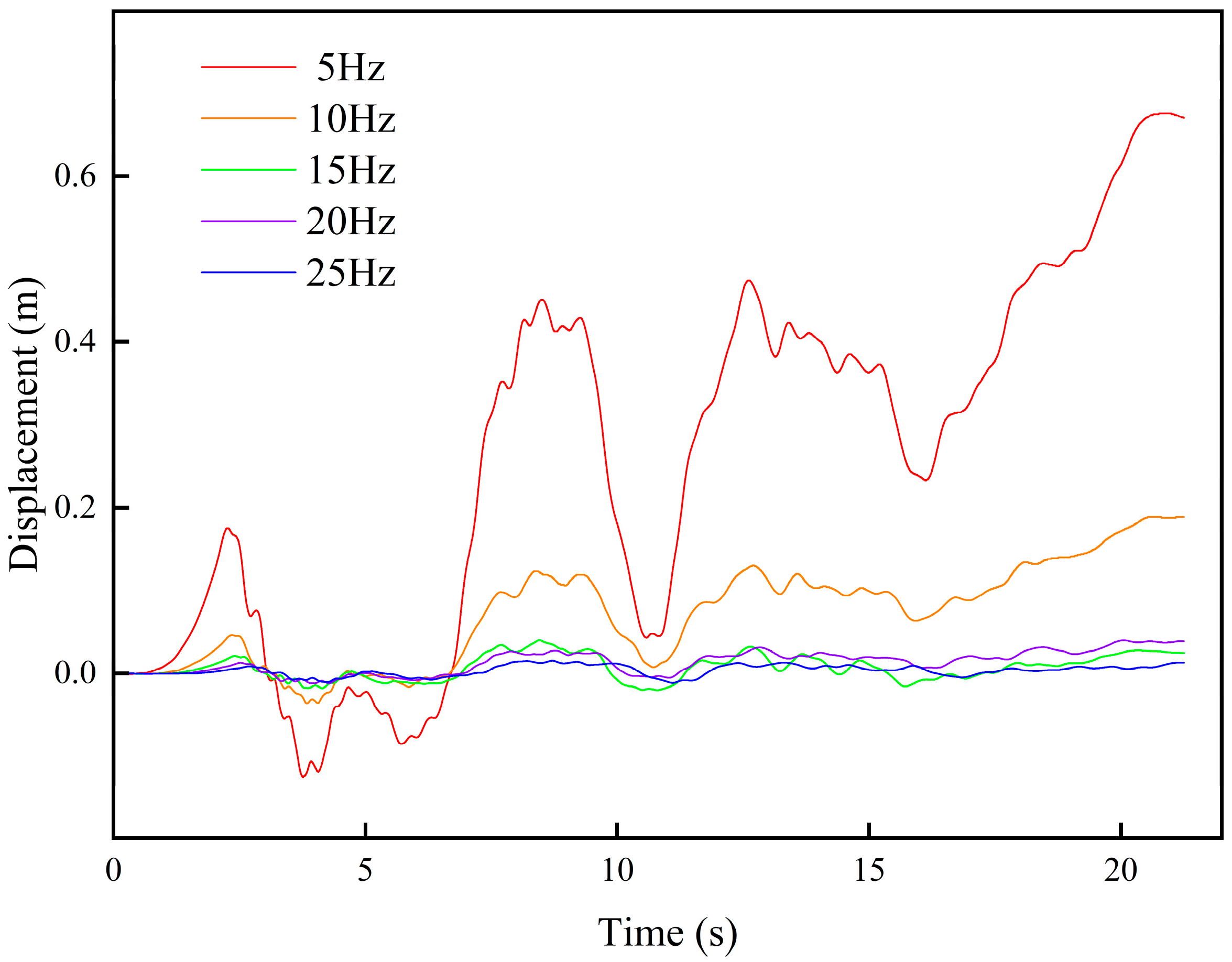
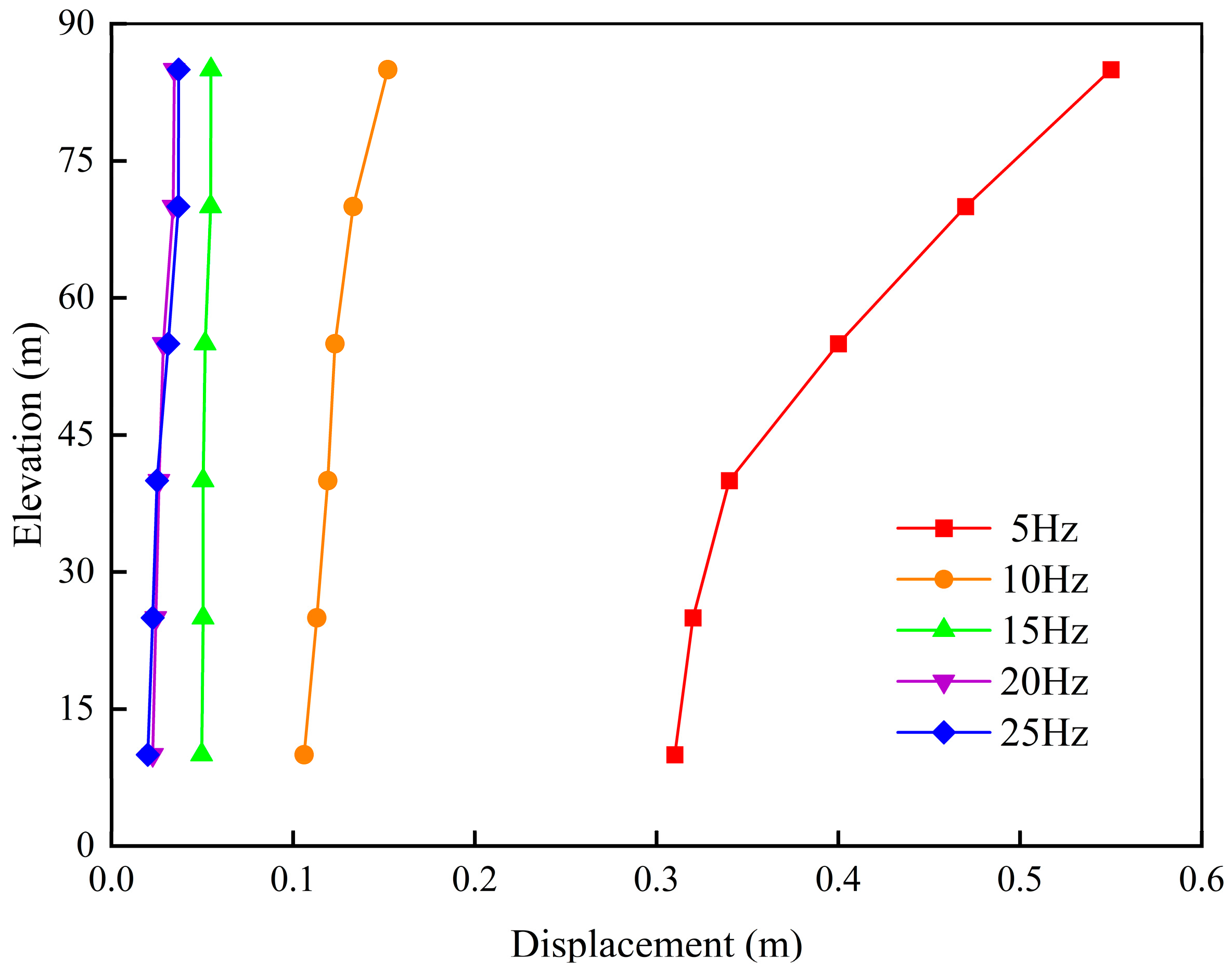




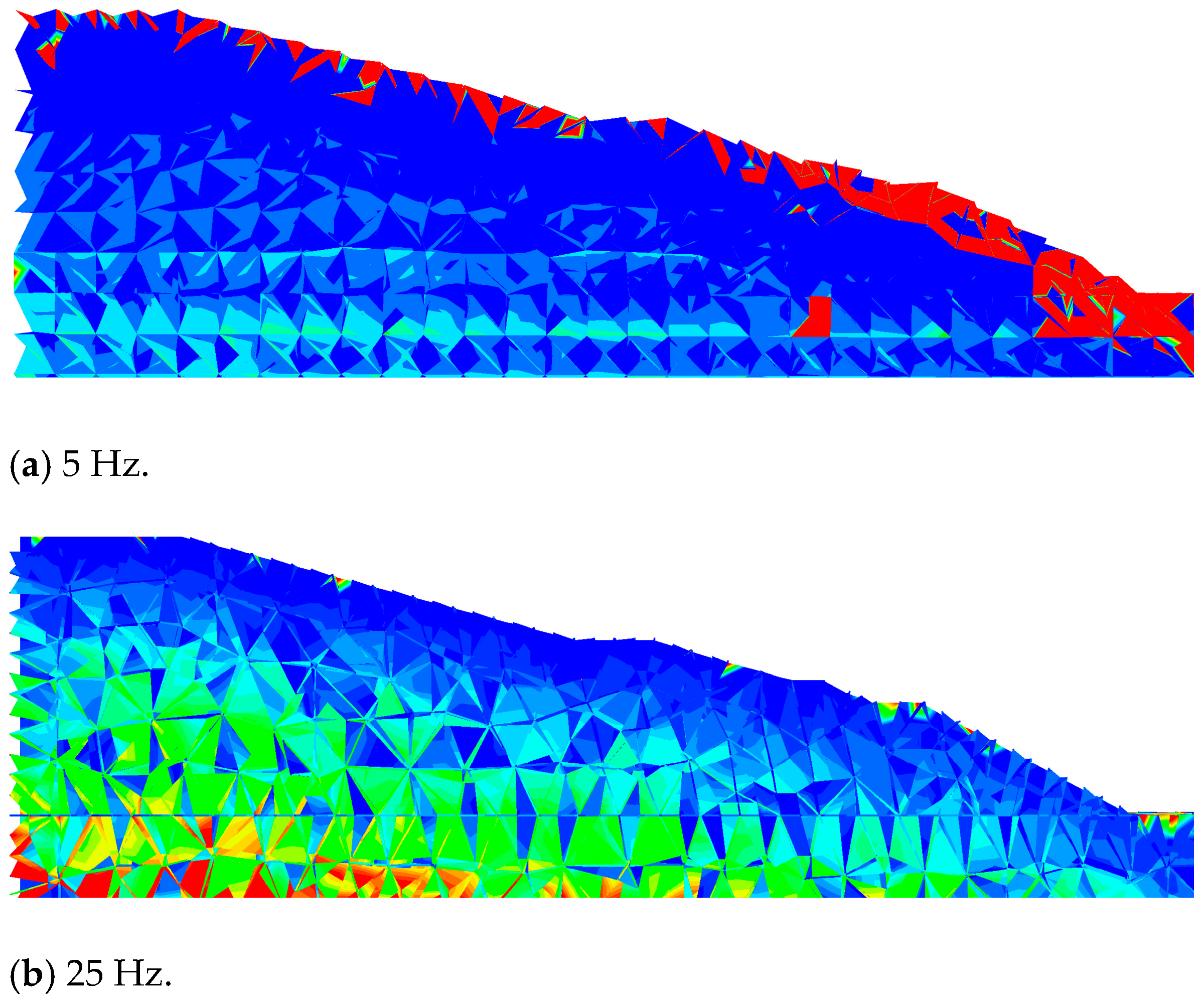
| Materials | Density /(kg·m−3) | Porosity | Internal Friction Angle/(°) | Cohesion/(kPa) | Young’s Modulus /(GPa) | Poisson’s Ratio |
|---|---|---|---|---|---|---|
| Uranium tailings sand | 1850 | 0.5 | 30 | 6 | 0.36 | 0.3 |
| Saturated uranium tailings sand | 2050 | 0.5 | 28 | 8 | 0.36 | 0.27 |
| Tail powder soil | 2050 | 0.39 | 18 | 10 | 0.61 | 0.28 |
| Initial dam | 1860 | 0.39 | 19 | 61 | 0.28 | 0.32 |
| Base rock | 2040 | 0.43 | 20 | 60 | 1.05 | 0.28 |
| Monitoring Point | Elevation /m | Peak X-Velocity /(m·s−1) | Horizontal Velocity Amplification Factor | Peak X-Displacement/(cm) | X-Displacement Amplification Factor |
|---|---|---|---|---|---|
| A1 | 10 | 0.143 | 0.99 | 10.6 | 0.91 |
| A2 | 25 | 0.156 | 1.08 | 11.3 | 0.97 |
| A3 | 40 | 0.167 | 1.16 | 11.9 | 1.02 |
| A4 | 55 | 0.188 | 1.31 | 12.3 | 1.05 |
| A5 | 70 | 0.169 | 1.17 | 13.3 | 1.14 |
| A6 | 85 | 0.154 | 1.07 | 15.2 | 1.30 |
| B1 | 10 | 0.158 | 1.11 | 15.0 | 1.28 |
| B2 | 25 | 0.148 | 1.03 | 16.4 | 1.40 |
| B3 | 40 | 0.170 | 1.18 | 17.6 | 1.50 |
| B4 | 55 | 0.177 | 1.23 | 18.9 | 1.62 |
| B5 | 70 | 0.178 | 1.24 | 20.8 | 1.78 |
| C1 | 10 | 0.147 | 1.02 | 15.4 | 1.32 |
| C2 | 25 | 0.131 | 0.91 | 17.1 | 1.46 |
| C3 | 40 | 0.145 | 1.01 | 19.2 | 1.64 |
| C4 | 55 | 0.159 | 1.10 | 22.6 | 1.93 |
| D1 | 10 | 0.130 | 0.90 | 15.8 | 1.35 |
| D2 | 25 | 0.126 | 0.88 | 17.6 | 1.50 |
| D3 | 40 | 0.170 | 1.18 | 21.2 | 1.81 |
| E1 | 10 | 0.131 | 0.91 | 17.5 | 1.50 |
| E2 | 25 | 0.146 | 1.01 | 20.7 | 1.77 |
Disclaimer/Publisher’s Note: The statements, opinions and data contained in all publications are solely those of the individual author(s) and contributor(s) and not of MDPI and/or the editor(s). MDPI and/or the editor(s) disclaim responsibility for any injury to people or property resulting from any ideas, methods, instructions or products referred to in the content. |
© 2024 by the authors. Licensee MDPI, Basel, Switzerland. This article is an open access article distributed under the terms and conditions of the Creative Commons Attribution (CC BY) license (https://creativecommons.org/licenses/by/4.0/).
Share and Cite
Lan, M.; Huang, H.; He, Y. Characterization of Seismic Dynamic Response of Uranium Tailings Dams Based on Discrete Element Method. Appl. Sci. 2024, 14, 8389. https://doi.org/10.3390/app14188389
Lan M, Huang H, He Y. Characterization of Seismic Dynamic Response of Uranium Tailings Dams Based on Discrete Element Method. Applied Sciences. 2024; 14(18):8389. https://doi.org/10.3390/app14188389
Chicago/Turabian StyleLan, Ming, Hongyu Huang, and Yan He. 2024. "Characterization of Seismic Dynamic Response of Uranium Tailings Dams Based on Discrete Element Method" Applied Sciences 14, no. 18: 8389. https://doi.org/10.3390/app14188389






